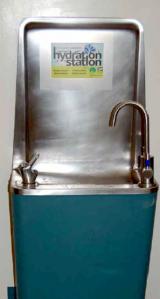Trash-Free Waters Projects
EPA has funded various projects designed to prevent trash from entering waterways.
- San Francisco Bay Area Trash Capture Demonstration Project
Recipient: San Francisco Estuary Partnership
EPA Funding: $ 735,000 Match Funding: $4,265,000
Funding Program: American Recovery and Reinvestment Act through State Revolving Fund
Project Period: 2009-2014
Partners: State Water Resource Control Board, Association of Bay Area Governments, and 60 local municipalitiesProject Description
The purpose of this project was to facilitate funding to Bay Area municipalities for trash capture devices to help fulfill stormwater permit trash requirements while helping municipal staff gain knowledge of different device types and their appropriateness to different land uses. Purchasing and installing trash capture devices was helpful to many municipalities in meeting trash reduction goals of 40% by 2014, 70% by 2017, and 100% by 2022 as called for in the San Francisco Regional Stormwater Permit.
The project also developed the Bay Area Trash Tracker, a password-protected online resource for municipalities, which maps device installations and allows local staff to upload and download maintenance data. This tool is being expanded for public use by the state grant-funded project Tracking California's Trash. Exit
San Francisco Estuary Partnership is one of 28 National Estuary Programs authorized under Section 320 of the Clean Water Act. A more in-depth project description and final report is available on the San Francisco Esutary Partnership Exit website.
Outputs
- Installed over 4,000 small to medium trash capture devices in more than 60 Bay Area jurisdictions
- Installed 42 large trash devices
- Created a password-protected online tool to assist municipalities in tracking maintenance of the trash capture devices
Examples of Devices Installed Under the San Francisco Bay Area Trash Capture Demonstration Project
The availability of a funding source to purchase and install trash capture devices was helpful to many municipalities in meeting their target trash reduction goals of 40% in 2014 and 70% in 2017.
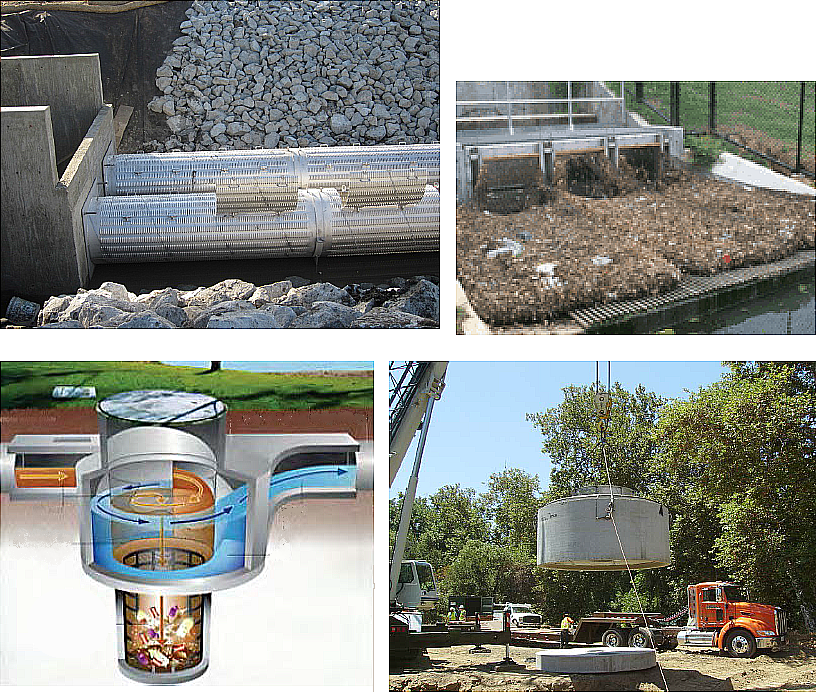 Clockwise from top-left: A gross solids removal device, Large trash nets collecting trash and vegetation after a storm, installation of a hydrodynamic separator in San Jose, California, A diagram of a hydrodynamic Separator.
Clockwise from top-left: A gross solids removal device, Large trash nets collecting trash and vegetation after a storm, installation of a hydrodynamic separator in San Jose, California, A diagram of a hydrodynamic Separator. - Hayward Youth-Based Trash Capture, Reduction, and Watershed Education Project
Recipient: City of Hayward
EPA Funding: $ 800,000 Match Funding: $ 800,000
Funding Program: San Francisco Bay Water Quality Improvement Fund
Project Period: 2015-2018
Partners: City of Hayward Schools Districts, Private schools, Local Park districts, Local College InternsProject Description
This project will capture trash and prevent it from polluting local watersheds, characterize and quantify the trash collected, and implement actions to engage the public, specifically youth, to prevent littering. Under the Bay Area stormwater permit, Hayward is one of more than 60 municipalities responsible for achieving a 100% reduction in trash discharges into San Francisco Bay by 2022. Hayward is implementing a first-through-12th grade trash reduction curriculum in all Hayward schools during the project period in partnership with public and private schools and college interns. High school curriculum will include more sophisticated aspects of trash reduction, including trash capture design and attending trash capture device installation and/or clean-out. Hayward will use grant funding to install three new large capture devices treating over 1000 acres of the city's watersheds and preventing over 20,000 gallons of trash from entering San Francisco Bay per year.
Outputs
- Install 3 large capture devices
- Treat over 1,000 acres of high trash generating area
- Prevent over 20,000 gallons of trash from entering the San Francisco Bay per year
- Trash reduction curriculum to be taught in all schools in Hayward
City of Hayward Video - Saving the Bay: The Trash Capture Device Under Your Feet
- Coyote Creek Trash Reduction Project: Clean Creeks, Healthy Communities
Recipient: City of San Jose, Environmental Services Department
EPA Funding: $680,000 Recipient Match: $382,417
Funding Program: San Francisco Bay Water Quality Improvement Fund
Project Period: 2011- 2016
Partners: Downtown Streets Team, Destination Home, Santa Clara Valley Water District, eBayProject Description
The City of San Jose is working with the community to improve water quality in Coyote Creek by addressing trash at its source: litter, illegal encampments and illegal dumping. One of the most chronic and significant causes of trash impairment on Coyote Creek has been homeless encampments. San Jose staff have worked with the surrounding neighborhoods to prevent litter and eliminate illegal dumping sites through environmental education and outreach events which have developed local stewardship groups that maintain public accessibility of creekside trails. San Jose also worked with partners Downtown Street Team and Destination Home on peer to peer outreach to homeless individuals living along Coyote Creek. The project has resulted in permanent housing for 50 individuals who formerly lived in the targeted reach of the creek, and includes thousands of hours of community cleaning and monitoring of riparian areas, which enlisted many homeless individuals to form clean-up crews.
Outputs
- 8 large scale illegal encampment cleanups
- Install surveillance camera and eliminate 4 chronic dumpsites
- 2 public art projects
- Create anti-dumping webpage
- Clean Streets Team Video
- 8 assessments to document change in trash
Clean Streets Team Video
- ReThink Disposable: Packaging Waste Source Reduction Pilot Project for San Francisco Bay Area Restaurants
Recipient: Clean Water Fund
EPA Funding: $257,293 Recipient Match: $85,764
Funding Program: San Francisco Bay Water Quality Improvement Fund
Project Period: 2012 – 2015
Partners: Oakland, San Francisco, South San Francisco, Sunnyvale, San Jose, and San Mateo County and respective business communities and restaurant owners.Project Description
Clean Water Fund created a pilot project called ReThink Disposable Exit to work with local governments and food establishments to develop cost-effective models to reduce takeout food disposable packaging. In earlier years the organization conducted a litter survey in the Bay Area finding that 67% of trash in storm drains or catch basins were food and beverage take-out related. ReThink Disposable is a free technical assistance program that helps food businesses implement best practices to reduce use of disposable food serviceware resulting in reduced waste and cutting costs by minimizing disposable product usage. The project is working with local municipalities to target reductions in takeout food packaging in restaurants by performing outreach, enrolling restaurants in the program and developing practical source reduction methods tailored for each local businesses.
Outputs
- Enrolled over 46 Bay Area restaurants and 9 food trucks in the program
- Quantitative analysis of Source Reduction of disposables at 30 restaurants
- Reduced over 2.8 million disposable foodware packaging items annually
- Reduced 14.8 tons of waste annually
- Saved Businesses an average of $3000 annually
The ReThink Disposable program received the Governors Environmental and Economic Leadership Award Exit in 2015 from the California EPA which recognizes individuals, organizations, and businesses that have demonstrated exceptional leadership and made notable contributions in conserving our precious resources, protecting and enhancing our environment, and building public-private partnerships.
ReThink Disposable is a Three Step Process
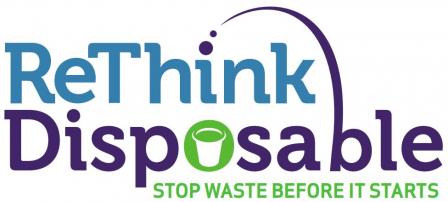
- Conduct a baseline inventory of the quantity and costs of the disposable products used.
- Provide consultation on individually tailored recommendations for each business and provide resources and information on a variety of alternative products and reusable substitutions.
- Measure and report the annual amount of waste reduced and cost savings after implementation of selected changes.
Sample Best Management Practices to Reduce Disposable Food Serviceware
- Eliminate non-necessary disposable items or make available upon request only (i.e. straws, drink stirrers, toothpicks, etc.)
- Make optional disposable items self-serve (drink and container lids, hot cup sleeves, napkins in a one at a time dispenser)
- Use bulk condiments, seasonings and sweeteners – no packets
- Use reusable dishware for on-site dining (cups, plates, bowls, portion cups, cutlery, etc.)
- Offer and advertise reusable cup incentive
- Offer and advertise reusable container incentive
- Establish staff policies and training (always ask for here or to go, ask first for disposables such as bags and receipts)
- Implement customer education and engagement
- Eliminate excess packaging
Examples of Source Reduction Outputs
Sacred Wheel in Oakland
- Saved $3,768 total annually
- Eliminated 602 pounds of single-use disposable waste
By making these 4 recommendations
- Replace disposable tasting spoons, cups, bowls, cutlery and condiment cups with reusable dishware for on-site dining
- Offer napkins in a self-serve dispenser
- Make straws available upon request only
- Ask before giving customers disposable items like utensil and napkins for to-go orders
Previously, Sacred Wheel had switched to compostable disposable packaging, because they thought this was the best thing to do for the environment. However, the compostable plastics Sacred Wheel was using to serve food and beverages couldn't be composted in Oakland and were instead being sent to the landfill and they were quite expensive. They realized that real dishes were the best option for Sacred Wheel and are also more eco-friendly. The Sacred Wheel team was able to split up the dish washing responsibilities without adding any extra staff time. This kept costs low and allowed Sacred Wheel to recover the full savings from reduced disposable purchases. For more information see the full case study.(2 pp, 1.5 MB, About PDF) Exit
- Reducing Food Service Plastics on University of California Campuses: Developing a Process for Implementing Source Reduction in Institutional Settings
Recipient: Product Stewardship Institute
EPA Funding: $164,245 Recipient match: $83,218
Funding Program: West Coast Estuaries Initiative for the California Coast
Project Period: 2012 - 2015
Partners: Plastic Pollution Coalition, California Product Stewardship Council, Clean Water Fund California, and University of California Office of the President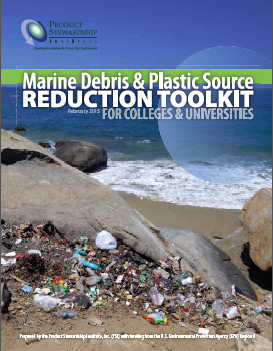 Download the Marine Debris & Plastic Source Reduction Toolkit for Colleges & UniversitiesProject Description
Download the Marine Debris & Plastic Source Reduction Toolkit for Colleges & UniversitiesProject DescriptionThe Product Stewardship Institute (PSI) designed and implemented a project to promote plastic source reduction on three University of California (UC) campuses: UC Santa Barbara (UCSB), UC San Francisco (UCSF), and UC San Diego (UCSD).
PSI worked with these campuses to identify and implement strategies consistent with each campuses unique waste management infrastructure to eliminate or reduce the use of disposable plastics in food service settings, including replacing single-use plastics with durable, reusable products or those that have minimal environmental impact.
During the project, PSI developed the Marine Debris & Plastic Source Reduction Toolkit for Colleges & Universities which outlines repeatable process to approach source reduction in an institutional setting such as university campuses complete with case studies and lessons learned from each participating campus.
- The toolkit identifies four steps in reducing packaging on campus:
- Determining the campus's plastic footprint to identify reduction opportunities;
- Creating a source reduction plan to reduce or eliminate the use of disposable plastic items;
- Changing campus procurement practices by identifying less environmentally impactful products;
- Establishing municipal and/or campus-wide source reduction policies.
Full case studies for each campus can be found in the toolkit link above.
Case Study Highlights
University of California Santa Barbara (UCSB)
Top 5 disposable plastic items at UCSB were lids, cutlery, straws, water bottles, and bags. UCSB targeted bottle and bags reduction.
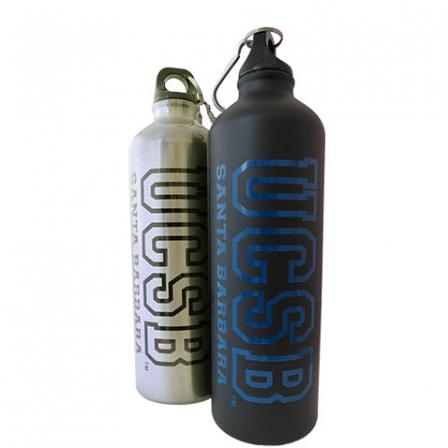
- Elimination of 60,124 single-use plastic water bottles and a 54 percent decline in single-use water bottle sales by UCSB improved signage for their hydration stations and reusable water bottles were given to incoming freshman
- Elimination of 34,550 of the 35,000 plastic bags used on campus per year. UCSB convinced the Subway store on their campus to cease the purchase of plastic bags, the franchisee's decision resulted in a 97 percent decline in plastic bag use on campus.
University of California San Francisco (UCSF)
Top 5 disposable plastic items: cutlery, lids, soda and juice bottles, straws, and water bottles. UCSF targeted reduction of water bottles and switch to compostable cutlery and lids as this was compatible with their waste management infrastructure.
- Elimination of 50% of the campus's purchase of single-use bottled water by 50 percent, saving $27,500 each year by retrofitting over 60 of its on-campus water fountains with gooseneck spouts allowing users to more easily refill reusable water bottles
- Use of compostable cutlery is known as substitution rather than source reduction since it does not actually eliminate the single-use disposable items.
Limited research is available on how compostable plastics behave in the marine environment as they are designed to degrade in the high temperatures of industrial composting facilities. There is currently no definition for marine degradable plastics.
University of California San Diego (UCSD)
Top 5 item at UCSD were cups, bags, lids, cutlery, and clamshells. UCSF targeted reduction of cups, bags, and clamshells.
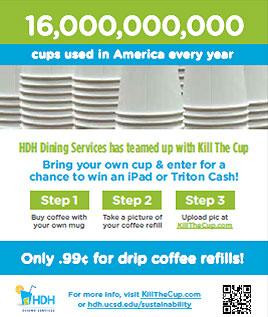
- Increased the use of reusable cups by 70% by placing advertisements at all registers and a student initiated "Kill the Cup" campaign and providing a 20-cent discount on coffee and all fountain drinks to students at campus-managed eateries if they bring their own reusable cup or mug.
- Eliminating over 1 million sandwich sleeve bags each year also by convinced the Subway on campus to eliminate its use of plastic bags and plastic straw sleeves.
- Piloting a reusable container system to reduce clamshell use.
- Piloted compostable cups and cutlery were found incompatible with composting provider's 10-week process.
- Ocean Plastic Pollution Summit for Teachers: Teachers creating source reduction lessons and projects to address ocean plastic pollution
Recipient: Monterey Bay Aquarium
EPA Funding: $ 50,000 Recipient match: $60,000
Project Period: 2012-2013
Partners: Johnson Ohana Charitable Foundation and 100 schools
Funding Program: West Coast Estuaries Initiative for the California Coast
Project Period: 2012 - 2015
Partners: Plastic Pollution Coalition, California Product Stewardship Council, Clean Water Fund California, and University of CaliforniaProject Description
The Monterey Bay Aquarium piloted the 2012 Ocean Plastic Pollution Summit. Attendees were K-12 teachers from around the region who wanted to learn more about the marine debris and develop and implement 'action-oriented' projects in their schools to help stop ocean plastic pollution. The summit consisted of three in-person summit sessions for teachers to engage with speakers, scientists and community organizations working to address the sources of ocean plastic pollution and raise public awareness.
- Kick-off Summit session: teachers participated in hands- on sessions about plastics issues, civic action with students, science of styrofoam, source reduction strategies, living plastic free, recycling and downcycling of plastics, solutions to plastic pollution, and wildlife impacts. Teachers were asked to submit proposals for 'Action Projects' with their students.
- The second Summit activity was a midpoint check-in to allow teachers to share the challenges and successes strategies in implementing Action Projects.
- The third Summit activity included teachers, chaperones, and students in an event celebrated the completed Action Projects. Project teams of teachers and their students set up posters and displays of their projects and explained their results to their peers.
Outputs
The teachers with their students:- Developed 29 source reduction projects
- Impacted 20 watersheds and
- reached over 4,000 people with projects and awareness campaigns.
Source Reduction Projects fit in three categories including:- School trash/lunchroom audits
- Personal/family plastic use
- Environmental trash/effects on wildlife Campaigns
Examples of Source Reduction Outputs
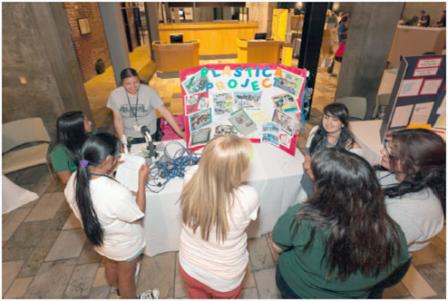
- Spork Audit
Students stood at the cafeteria lunch line marking items used by the students to collect data on the use of trays, milk cartons, food products, and spork combo kits (which include a spork and napkin in a plastic wrap). On average of 500 spork combos were being used per day, however, many students were requesting simply for the napkin inside. After offering a choice of a paper towel or sporks to students, there was a 60% reduction in spork use or 45,000 sporks eliminated per year. - Pledge to reduce single-use bags
After education about ocean plastic pollution, middle school students decided to focus on use of single-use plastic shopping bags and brought a pledge home to their parents. Surveys demonstrated on average plastic bag use decreased from 25 bags/week to 6 bags/week in student households. - Promoting Hydration Stations
Fifth grade students presented a lesson to 4th grade about effects of plastic pollution on sea turtles and proposed to the class a project to reduce disposable water bottle use on campus by encouraging the use of refilling reusable alternatives at the schools water fountains. Surveys of the 4th grade class demonstrated an increase from 50 to 70% of students bringing reusable bottles.


